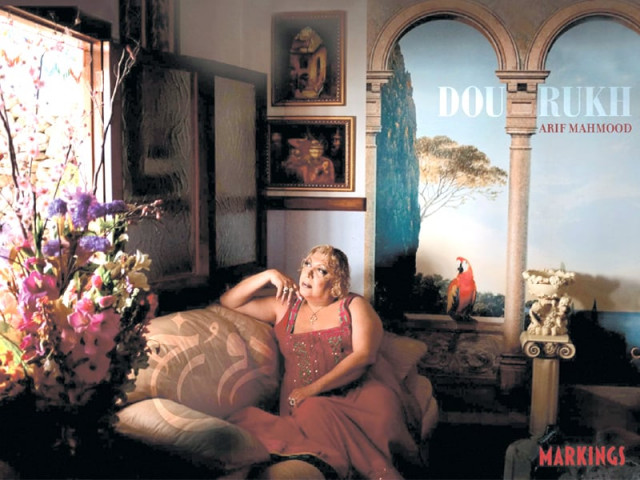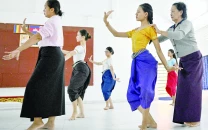Dou Rukh: Capturing duality
Tapu Javeri and Arif Mahmood’s book represents how two drastically different photographers construct a portrait.

Dou Rukh: Capturing duality
A journey through various perceptions and realities, Dou Rukh might be a catalogue of controversies for some, but for many, it’s a book embedded with philosophy.
The book, fashion photographer Tapu Javeri and photojournalist Arif Mahmood’s combined venture published by Markings, is a photographic representation of two individual perspectives on the same subjects. Each portrait expresses the photographer’s distinct composition, framework, lighting and connection with the subjects. “Dou Rukh has enabled us to show how differently we envision our subjects and hence the world,” said Javeri.
Art lovers, both young and old, along with socialites and fashionistas including Bunto Kazmi, Shamaeel Ansari, Nida Azwer, Deepak Perwani, Adnan Pardesy, Warda Saleem and Rizwanul Haq, to name a few, were present at the Indus Valley School of Art and Architecture to celebrate the launch of the book — Javeri’s fifth and Mahmood’s eighth so far. “I love Arif Mahmood’s works. Not many people are in photojournalism — it requires minimal editing and is more difficult than fashion photography,” stated Haya Rizwan, a second year Communication Design student, adding that she cannot wait to get her hands on the book which costs Rs1,200.
Before the launch, visitors were shown to the art gallery where almost 35 portraits from the book were on display. The subjects belonged to various professions including TV host Mathira, humanitarian Abdul Sattar Edhi, artist Durriya Kazi, musician Ali Zafar, socialite Marzi Kanga, poet Zehra Nigah and veteran actor Shakeel.
Spotted at the event was fashion journalist Mohsin Sayeed who was moved by the concept of ‘two perspectives’. “I also love the fact that the book is not just about the glamorous faces and includes people like Abdul Sattar Edhi, who have contributed a lot the society,” said Sayeed. Appreciation and criticism go together as Sayeed looked around the gallery more closely. “I personally like the portraits of Zehra Nigah and Haseena Moin, but Reema’s is way too predictable. The photographers are trying to portray some degree of simplicity through this portrait but it’s not coming through.” What was more alarming was his reaction to the cover of the book, “Why Marzi of all the people? And would it have any commercial value?”
However, Mahmood sees beauty in the cover, “My favourite pictures are of Marzi’s and Shakeel’s. What I like about Marzi’s portrait is that she better gels into the background and the surrounding settings. She is part of the painting. On the other hand, the light through the window was just right to make Shakeel appear as if coming out of the darkness into ethereal space.”
Meanwhile, Javeri found shooting the qawwals very challenging. “Capturing the qawwals; Abu and Fareed Ayaz was very testing. I wanted a certain Sufi mood so I shot them with a slow shutter speed, rhythmically swirling my camera to follow their movements so that I got the desired effect. It took a long time and I looked like a fool sitting on stage shaking a camera at them, but it was worth it,” said Javeri whose previous books Tapulicious, Shades of Green, K’Architecture and I and Voyeur have been well-received.
When asked how important Photoshop is in his final images, Mahmood replied, “For digital work I use it to correct levels of the image and dodge and burn certain areas if required.” Javeri, on the other hand, stated, “It depends. In fashion work, Photoshop has become a necessity, since the final image is artificial, made to sell a product not tell a story. In Dou Rukh, I have unashamedly used Photoshop in Rizwan Beyg’s portrait because I wanted to make him larger than life.”
Following a light session, with some chitchatting and others gazing intensely at the portraits, the crowd moved out to the courtyard where Javeri and Mahmood initiated the formal launch of the book. The two invited all the personalities who agreed to be part of the book to the stage, with Shakeel being the first one to speak. “These people are great masters of the art. Everyone has two sides to himself and these people have tried to capture those. When you take the soul out of the person who is being photographed and put it in the picture; that is real art.”
TV host Mathira concluded the event with, “I’m really happy that Tapu and Arif chose to include me in the book. Love you darlings, muah.”
Published in The Express Tribune, October 2nd, 2011.



















COMMENTS
Comments are moderated and generally will be posted if they are on-topic and not abusive.
For more information, please see our Comments FAQ